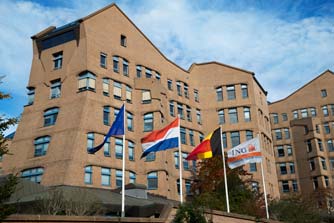Building the preferred bank
Building the preferred bank
In January 2012, ING Bank launched a new strategy. It announced, that until the end of 2013, the bank would focus on repaying the Dutch State, completing the EC restructuring and meeting the increased capital requirements known as Basel III.

The Bank worked steadfastly towards these objectives in 2012.
In late November 2012, ING announced it had paid EUR 1.125 billion to the Dutch State, including a EUR 750 million repayment of core Tier 1 securities and EUR 375 million in premiums and interest. The repayment brought the total paid to the Dutch State to EUR 10.2 billion including EUR 7.8 billion in principal and EUR 2.4 billion in interest and premiums.
Also in November, ING and the Dutch State reached an agreement with the European Commission (EC) on a revised restructuring plan. The original restructuring plan negotiated in 2009 was required by the EC in order for ING to gain EC approval for State aid received from the Dutch government in 2008 and early 2009.
The revised restructuring plan gave ING more flexibility to complete the required divestments and to make adjustments on other commitments in light of the market environment, economic climate and more stringent regulation.
Under the terms of the original restructuring plan, ING was required to divest WestlandUtrecht Bank. However, due to market circumstances and changing regulatory requirements, this had not been feasible.
Under the amended terms of the restructuring plan, the commercial operations of WestlandUtrecht Bank will be combined with the retail banking activities of Dutch insurer Nationale-Nederlanden, which is to be divested as part of Insurance/Investment Management Europe. The integrated retail banking business will operate under the Nationale-Nederlanden brand, with the goal of becoming a competitive retail bank in the Dutch market with its own funding capabilities and a broad distribution network. WestlandUtrecht’s mortgage portfolio will be largely retained by ING Bank.
The original restructuring plan required ING, among many other things, to divest ING Direct USA. In February 2012, the sale of ING Direct USA to Capital One Financial Corporation was completed. The transaction resulted in a positive result after tax of approximately EUR 0.5 billion. As part of the sale of ING Direct USA to Capital One, ING obtained 54 million shares in Capital One. These were sold in September 2012 for a total value of approximately USD 3.0 billion (EUR 2.4 billion at the then current exchange rate).
Apart from the divestments required by the EC, ING also made a few divestments as a result of the continuous evaluation of its portfolio of businesses. This was in line with ING’s strategic objectives of sharpening the focus of the bank and further strengthening its capital position.
ING completed the sale of ING Direct Canada to Scotiabank for CAD 3.1 billion (EUR 2.4 billion at the then current exchange rate) in November 2012 and this resulted in a
total capital release EUR 1.3 billion, and a net transaction gain of EUR 1.1 billion after tax.
In October 2012, ING announced that it had reached an agreement to sell ING Direct UK to Barclays. This transaction is expected to close in the second quarter of 2013. The combined loss for the transfer of the business and the investment portfolio to Barclays of EUR 320 million will be offset by an expected total capital release of approximately EUR 330 million due to risk-weighted asset release.
Strengthening capital
In January 2012, as part of the launch of its strategy, the Bank unveiled Ambition 2015, a set of targets that included generating more capital and strengthening its capital buffer, the core Tier 1 capital, against adverse events.
At the end of 2012, the core Tier 1 ratio strengthened to a solid 11.9% under the international set of bank capital requirements, Basel II. This is above the Basel II benchmark, which calls for 7.5 per cent of a Bank’s capital to be set aside to protect a bank against losses. ING aims for a core Tier 1 ratio above 10% from 2013 onwards. This puts the Bank in a strong position to meet tougher capital requirements, under Basel III, to be phased in up to 2019. ING’s higher capital ratio means it is well above what is internationally required, and means the Bank has a very solid capital buffer. It is good news for customers and investors because it means the bank, in these times of financial and market volatility, is in a relatively better position to withstand future financial and operational risks.
Building the preferred bank
Building the preferred bank means delivering financial products and services in the way customers would like them delivered: with exemplary service, convenience and at competitive prices.
In 2012, ING Bank made significant progress on this by moving towards integrating its banking business. In several countries ING combined retail and commercial banking activities. ING also continued to evolve its various ING Direct units into banks offering a broader range of services to customers.
The retail banking operations focused on delivering low cost, simple and transparent products through multi-channels. Commercial Banking adapted its business operations to meet the challenging economic conditions and increasing regulatory demands. This involved streamlining operations, simplifying the client coverage model and exiting certain markets and products.

| 12 January | ING provides update on restructuring plans |
| 17 February | ING completes sale of ING Direct USA |
| 24 July | ING to appeal EC’s decision of 11 May 2012 re-approving 2009 restructuring plan |
| 29 August | ING to sell ING Direct Canada |
| 5 September | ING reaches agreement to sell all of its 54 million shares in Capital One |
| 3 October | ING meets EBA banking requirements |
| 9 October | ING to sell ING Direct UK |
| 15 November | ING completes sale ING Direct Canada |
| 19 November | ING reaches agreement on amended EC restructuring plan |
